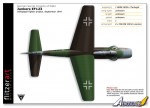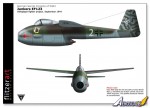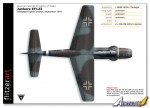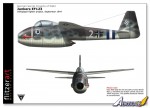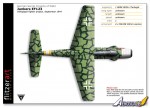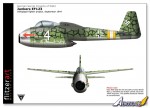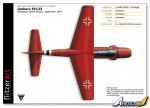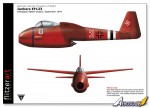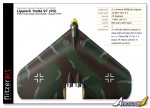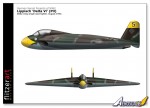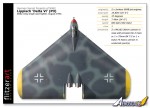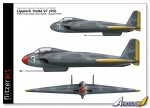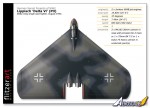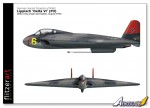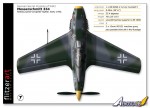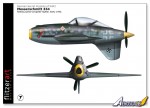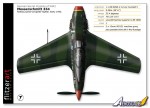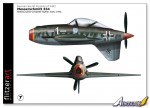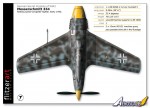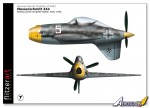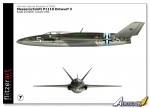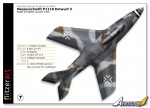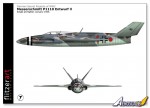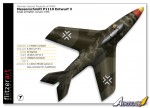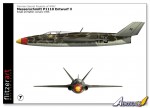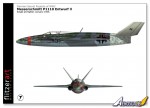German Secret Projects of WW2 Vol. 6
2
Comments
Junkers EF123 Volksjager
Numerous aircraft manufacturers responded to the RLM’s request for a Volksjager (people’s fighter), with Arado, Blohm and Voss, Fiesler, Heinkel, Junlkers and Siebel entering designs. In some cases more than one design were produced. However data is rather sketchy for some as much was lost at the war’s end or remains unfound.All data for Fiesler’s and Siebel’s designs was lost or at least have not been found and in the case of the Junkers EF123 little survived other than a few scale model photographs. So the profiles here are only an approximation of what the EF132 may have looked like.
No dimensions are known, but it would probably have been basically similar to the other manufacturer’s designs. Please see table at the foot of the page.
Lippisch Pll Fighter/fighter bomber
This is probably one of the lesser known secret projects from WW2, but in many ways showed the way ahead in many aspects, i.e. it could be argued it was way ahead of it’s time.The Pll was first designed in mid 1942 as a twin jet engined fast bomber, but RLM preferred the Horten HolX instead, so all work ceased. However the design was resurrected 12 months later due to a official request from the RLM for a ‘Very Fast Bomber’ based on Lippisch’s previous research.
After producing an unpowered glider to act as an initial prototype, under the new name of "Delta VI project", the project began in earnest. The RLM gave the highest priority on producing a fighter version. Models and mock-ups were made and wind tunnel research was carried out by the LFA (Aviation Research Institute) in preparation for production.
February 1944 saw, design work for the proposed fighter, fighter-bomber and heavy fighter nearly completed. The wing was swept back at 37 degrees, and the low wing loading promised a good climb capability and excellent manoeuvrability. Two MK 103 30mm cannon mounted in the wings, with a provision for an additional two MK 103 30mm cannon or one BK 7.5 75mm cannon in an external pack was to be the armament.
Flight tests with the unpowered glider were hoped to have been started by April 1944, with the two Jumo 004B turbojet powered version to be flying by July 1944. The centre section of the unpowered glider Delta VI was captured by American troops at Salzburg, this being the only part of the aircraft to be completed.
The construction method was as ground breaking as the design itself. The entire aircraft was mostly made of wood skinned with composite materials.
‘‘There was to be no frame - the production PII structure was to be a monocoque "with no load bearing frame". The surface was a stressed skin composite. The outer covering was of Dynal as Justo said but this was bonded to a core of Tronal.
Dynal and Tronal were both cellulose products by DAG (Dynamit AG - Troisdorf). Tronal was a type of wall board wet-cast from crushed wood pulp fibers -- some sources say expanded wool. The Tronal core would be covered by Dynal, which was a phenolic resin sheet.
The Tronal core and Dynal covering would be bonded with phenol-formaldehyde resin (Polystal V) and pressed into shape in a female/male form. Presumably the resulting surface would be quite smooth -- perhaps akin to the DH Mosquito molded in a similar way (albeit from quite different materials).’’
By Apophenia, www.secretprojects.co.uk
Using this method of construction the Li Pll along with the Ho 229 would have provided excellent stealth qualities.
Profile Notes: There where many stages and design variants, many as part of the development work and not as the final production model. These included wind tunnel models, an unpowered glider and a prototype powered by rocket motors. The final twin jet deign would have had many variants including fighter, heavy fighter/zerstorer, fighter-bomber and very fast bomber. The profiles here illustrate the fighter and heavy fighter versions.
In the case of the heavy fighter, I have done two versions to show the optional under-belly gun pod. The most familiar, to this aircraft design, shows the pod way back under the belly. The other shows the pod mounted much further forward under the cockpit as suggested by Mr Justo Miranda as a likely development. Mounting the pod so far forward would have negated the nose wheel position and would have probably needed a pair of retractable tail wheels housed one on each side and slightly ahead of the twin fins. In effect creating a quad undercarriage.
Messerschmitt 334 (Lippisch)
Designed in early 1943, the Me 334 was one of the few designs aimed at replacing jet power with a piston engine. This was due to early delays in production and availability of jet engines.Dr. Lippisch modified this aircraft to accept a Daimler Benz DB 605 12-cylinder piston engine. The wings were mounted mid-fuselage and were swept back at a 23.4 degree angle. The main landing gear retracted inwards and the front gear retracted to the rear. Intended armament was to be two or three MG 131 13mm machine guns.
Further development was abandoned after the Me163’s successful maiden flight, when Lippisch designed the P20.
Messerschmitt P1110
There were many variants concerning both the P1110 V1 and V2 fighters, but I remember seeing one design that had the intakes far forward of the wings’ leading edge faring onto the fuselage sides under the cockpit. I have searched and searched without success until recently. Thumbing through Justo Miranda’s Dossier No.18, there it was.This version is classed as Vll but seems to be an interim design, retaining the butterfly tail and ‘A’ wings from V1 but replacing the annular intake with those mentioned above. As far as I can tell, the other Vll variants all seem to be different attempts to accommodate the intakes further back on the fuselage sides behind or level with the wings trailing edges.
It is suggested this variant and subsequent ones with a more conventional swept tail were an influence on the post war SAAB 32 ‘Lansen’ although there is no official confirmation. Apart from the Messerschmitt having a single jet engine and the SAAB’s twin jet engine configuration and larger size, the similarity is quite striking.
The following references proved invaluable in helping me to produce these profiles. Many thanks to the following:
Dan Johnsonís Luft 46 site: www.luft46.com
Luftwaffe Secret Projects: Fighters 1939-1945 by Walter Schick and Ingolf Meyer,
Luftwaffe Secret Projects: Strategic Bombers 1935-1945 by Dieter Herwig and Heinz Rode.
Luftwaffe Secret Projects, Volume 3: Ground Attack & Special Purpose Aircraft by Dieter Herwig and Heinz Rode.
Jet Planes of the Third Reich Vols 1 and 2 by Manfred Griel
Reichdreams Dossier No 18 Lippisch and Messerschmitt Supersonic Projects by J. Miranda & P. Mercado
Plus special thanks to members of www.secretprojects.co.uk for advice and data and our very own Rowan (Merlin).
Many thanks. More on the way.
Comments
Thanks for a great article Peter. I know how long these profiles take!
Incredible that the P1110 was designed 65 years ago, and yet wouldn't look out of place if it had been submitted alongside the YF-22 and YF-23.
MAY 15, 2010 - 11:10 AM
Many thanks Rowan, Jean-Luc and back room staff for doing the hard work in getting it up and running.
Thanks Ben.
In many cases I think the designs were so far advanced there was little chance of making them work then. The situation was one of needing technology to catch up to make a success of them which is possibly why so many look bang up to date even today in many respects.
More in the prep shop.
Peter
MAY 16, 2010 - 07:33 AM
Copyright ©2021 by Peter Allen. Images also by copyright holder unless otherwise noted. The views and opinions expressed herein are solely the views and opinions of the authors and/or contributors to this Web site and do not necessarily represent the views and/or opinions of AeroScale, KitMaker Network, or Silver Star Enterrpises. Images also by copyright holder unless otherwise noted. Opinions expressed are those of the author(s) and not necessarily those of AeroScale. All rights reserved. Originally published on: 2010-05-15 00:00:00. Unique Reads: 23702





